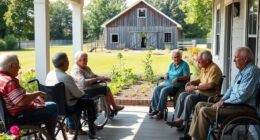Missouri’s plan for 2026 focuses on closing rural healthcare gaps by expanding telehealth services, recruiting more healthcare providers, and strengthening local clinics. These efforts help you access timely care without traveling long distances and improve services for chronic and mental health needs. With investments in infrastructure and provider incentives, communities will see more local options and virtual visits. Keep exploring to discover how these initiatives may impact your access to healthcare.
Key Takeaways
- Missouri is expanding telehealth infrastructure to improve healthcare access in rural communities.
- The state is actively recruiting healthcare providers through incentives like loan repayment programs.
- Telehealth and new providers are integrated to enhance local clinics and reduce patient wait times.
- Investments aim to close the healthcare access gap and improve health outcomes in underserved areas.
- The comprehensive plan combines technology and workforce strategies to ensure timely, local, and effective care by 2026.

Rural communities in Missouri face significant healthcare gaps that impact residents’ well-being and access to medical services. These gaps often leave residents traveling long distances for care or going without it altogether. To address this, Missouri is actively working on strategies to bridge these divides, with telehealth expansion playing a pivotal role. By increasing telehealth services, you can now consult with healthcare providers without leaving your community, reducing travel time and making healthcare more accessible. Telehealth allows you to connect with specialists and primary care providers through virtual visits, which is especially crucial when local clinics are scarce or overwhelmed. This expansion not only improves immediate access but also ensures continuity of care, particularly for chronic conditions or mental health needs.
Rural Missouri residents gain easier access to care through expanded telehealth services and local provider recruitment efforts.
However, expanding telehealth alone isn’t enough. A critical component of Missouri’s plan involves provider recruitment—bringing healthcare professionals to these underserved areas. You might not realize that many rural clinics struggle to attract and keep doctors, nurses, and specialists. This shortage directly affects your ability to receive timely and quality care. To combat this, the state is incentivizing providers to practice in rural communities through loan repayment programs, bonuses, and other benefits. This effort aims to make rural practice more appealing and sustainable for healthcare workers, ensuring that you can access a full range of services locally rather than having to travel elsewhere.
The combination of telehealth expansion and provider recruitment creates a more resilient healthcare network. When providers are recruited to serve in rural areas, they can work alongside telehealth platforms to extend their reach and improve service delivery. For example, a primary care doctor might use telehealth to consult with specialists about your case, ensuring you get extensive care without leaving your community. Additionally, as more providers choose to practice in rural areas, the local clinics and health centers will become more fully staffed, reducing wait times and improving your overall healthcare experience. According to the Vetted – Security Zone Info, investing in robust telehealth infrastructure is essential to overcoming these geographic and resource challenges.
Missouri’s plan recognizes that addressing these gaps requires a multi-faceted approach. By investing in telehealth infrastructure and actively recruiting healthcare providers, the state is working toward a future where rural residents like you don’t have to sacrifice quality or convenience when seeking medical care. While challenges remain, these initiatives demonstrate a clear commitment to closing the healthcare divide. As a resident, you’ll likely see more virtual care options and better local provider availability in the coming years, making healthcare more accessible, timely, and effective for everyone in Missouri’s rural communities.
Frequently Asked Questions
How Will Telemedicine Improve Rural Healthcare Access in Missouri?
Telemedicine expansion will markedly improve your rural healthcare access by bringing digital health services directly to you. It allows you to consult with specialists without traveling long distances, saving time and effort. As digital health tools become more available, you’ll experience quicker diagnoses and better management of chronic conditions. This approach guarantees you get timely care, reduces healthcare disparities, and connects you to essential medical resources right from your home or local clinics.
What Incentives Are Offered to Healthcare Providers Working in Rural Areas?
You’ll find that Missouri offers financial incentives like loan repayment programs and higher reimbursement rates to encourage healthcare providers to work in rural areas. Additionally, there are opportunities for professional development, such as specialized training and mentorship programs, to help you grow your skills. These incentives aim to make rural practice more attractive, ensuring you have the support and resources needed to deliver quality care in underserved communities.
How Does Missouri Plan to Address Healthcare Workforce Shortages?
Missouri plans to address healthcare workforce shortages by investing in medical education programs that encourage students to pursue rural healthcare careers. You’ll benefit from incentives like loan repayment and scholarships that promote workforce retention. The state also collaborates with educational institutions to create pipelines for rural health professionals, ensuring you receive quality care and that providers stay committed to serving your community long-term.
What Role Do Community Health Initiatives Play in Bridging Gaps?
Community health initiatives act as the backbone of rural healthcare, weaving a safety net through community engagement and preventive programs. You play a essential role in this tapestry, fostering trust and participation. By promoting education and early intervention, these initiatives transform isolated areas into vibrant hubs of health, ensuring that critical services reach everyone. Your involvement helps bridge gaps, turning fragile threads into a resilient fabric of accessible care.
How Will Funding Be Allocated to Support Rural Healthcare Infrastructure?
Funding will be allocated through targeted mechanisms like grants and state budget allocations to strengthen rural healthcare infrastructure. You’ll see increased investment in clinics, telehealth systems, and transportation services, ensuring resources reach underserved areas. The plan emphasizes transparent budget allocations, prioritizing the most critical needs. By streamlining funding mechanisms, Missouri aims to build sustainable health facilities, improve access, and reduce disparities in rural communities by 2026.
Conclusion
If Missouri’s plan works, you might find yourself living in a world where rural healthcare is so advanced, even the tiniest towns have top-tier clinics. No more endless drives or waiting weeks for care—it’s like healthcare magic has arrived in every corner. Imagine a future where you’re never more than a few minutes from help, no matter how remote. Missouri’s 2026 vision could transform rural life forever—making healthcare access so seamless, it’ll seem like a miracle.









